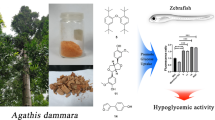Summary
The elimination, metabolism and distribution of14C-Total Flavanolic Oligomers (OFT), vitamin P factors extracted from “Vitis vinifera”, has been described, in the rat, as a function of time. This study was carried out using [U-14C]-OFT, [A-14C]-OFT and [B-14C]-OFT.
After a single oral administration of 50 mg/kg [U-14C]-OFT, about 70% of the administered dose is eliminated in the first 24 hours: 6% of the dose is excreted as14CO2 in expired air, 19% is eliminated in urine and 45% in faeces. The major urinary metabolites are hippuric acid, ethylcatechol and m-hydroxyphenylpropionic acid. The major faecal metabolite is ethylcatechol. The major biliary metabolites are vanillic acid and m-hydroxyphenylpropionic acid.
The degradation of OFT is dependent on the activity of the microflora in the gut.
The distribution of radioactivity in rat tissues shows that there are two kinds of target tissues for OFT: connective tissues and tissues of the adrenal-thyroid-pituitary axis.
Similar content being viewed by others
References
Booth, A.N., Murray, Ch. W., Jones, FT. and De Eds, F. (1956): The metabolic fate of rutin and quercetin in the animal body. J. Biol. Chem.,223, 251.
Kallianos, A.G., Petrakis, P.L., Shetlar, M.R. and Wender, S.H. (1959): Preliminary studies on degradation products of quercetin in rat’s gastro-intestinal tact. Arch. Biochem. Biophys.,81, 430.
Oshima, Y. and Watanabe, H. (1958): The mechanism of catechins metabolism. II Neutral substances in the urine of rabbits administered (+)-catechin. J. Biochem.,45, 12, 973.
Oshima, Y., Watanabe, H. and Isakari, S. (1958): The mechanisms of catechins metabolism. I Acidic substance in the urine of rabbits administered (+)-catechin. J. Biochem.,45, 11, 861.
Das N.P. and Griffiths, L.A. (1968): Studies on flavonoid metabolism. Metabolism of (+)-catechin in the guinea pig. Biochem. J.,110, 449.
Griffiths, L.A. (1969): Studies on flavonoid metabolism. Identification of the metabolites of (+)-catechin in rat urine. Biochem. J.,92, 173.
Das, N.P. (1971): Studies on flavonoid metabolism. Absorption and metabolism of (+)-catechin in man. Biochem. Pharmacol.,20, 3435.
Weinges, K., Kaltenhauser, W., Marx, H.D., Nader, E., Nader, F., Perner, J. and Seiler, D. (1968): Procyanidine aus Früchten. Liebigs ann. Chem. Dtsch.,711, 184.
Michaud, J. et Masquelier, J. (1973): Quelques aspects nouveaux de la connaissance des tannins catéchiques, leur relation avec la vitamine C2 (P). Produits et problèmes pharmaceutiques.28, 7, 499.
Harmand, M.F. (1977): Etude pharmacodynamique des Oligomères Flavanoliques. Totaux extraits de “Pinus Maritima” ou “Vitis Vinifera L.”. Modèle d’action physiologique. Thèse Doctorat ès-sicences, No 501 Bordeaux.
Michaud, J., Lacaze, P. et Masquelier, J. (1971): Fractionnement des Oligomères Flavanoliques du raisin. Bull. Soc. Pharm. Bordeaux.,40, 111.
Ribereau-Gayon (1966): Etude du métabolisme des glucides, des acides organiques et des acides aminés chez “Vitis Vinifera L.” Thèse Sci. Phys. Paris, No 5560.
Glasson, B. et Benakis, A. (1966): L’étude métabolique des médicaments marqués: description d’un plan expérimental. J. Lab. Comp.2, 2, 210.
Smith, I. (1960): Phenolic acids in “Chromatographic and electrophoretic techniques. “Vol. 1, Ch. 16, W. Heinemann Medical Books Ed., London.
Roux, D.G. and Maihs, A.E. (1960): Selective spray reagents for the identification and estimation of flavonoid compounds associated with condensed tannins. J. Chromatogr.,4, 65.
Nakagawa, Y., Shetlar, M.R. and Wender, S.H. (1964): Spectral identification studies of phenolic acids using aluminium chloride. Anal. Biochem.,7, 374.
Umberger, G.V. and Fiorese, F.F. (1963): Colorimetric method for hippuric acid. Clin. Chem.,9, 91.
Scheline, R.R. (1968): The metabolism of drugs and other organic compounds by the intestinal microflora. Acta Pharmacol. et Toxicol.,26, 332.
Bentsath, A., Rusznyak, S.T. and Szent-Györgyi, A. (1936): Vitamin nature of flavones. Nature, London,138, 798.
Author information
Authors and Affiliations
Rights and permissions
About this article
Cite this article
Harmand, M.F., Blanquet, P. The fate of total Flavanolic Oligomers (OFT) extracted from “Vitis vinifera L.” in the rat. European Journal of Drug Metabolism and Pharmacokinetics 3, 15–30 (1978). https://doi.org/10.1007/BF03189365
Received:
Issue Date:
DOI: https://doi.org/10.1007/BF03189365




